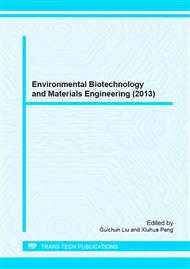[1]
Zhang Qin, Zhou Xingwei, Zhou Jian. Bioflocculation/Three-stage constructed wetland for enhanced treatment of high-concentration domestic sewage [J]. China water &wastewater. 2009, (01): 54-58.
Google Scholar
[2]
Wang Shutao. Advanced Treatment of Secondary Effluent by Combined Pre-Ozonation and Biofiltration [D]. Harbin Institute of Technology, (2007).
Google Scholar
[3]
X.P. Huang, L.M. Huang, W.Z. Yue. The characteristics of nutrients and eutrophication in the Pearl River estuary [J]. South China. Marine pollution bulletin, 2003 , 47: 30-36.
DOI: 10.1016/s0025-326x(02)00474-5
Google Scholar
[4]
Kuba T, van Loosdrecht M C M, Heijnen J J. Phosphorus and nitrogen removal with minimal COD requirement by integration of denitrifying dephosphatation and nitrification in a two-sludge system [J]. Water Research, 1996, 30(7): 1702-1710.
DOI: 10.1016/0043-1354(96)00050-4
Google Scholar
[5]
Liu Jinli. Performance of Treating DO Mestic Sewage with Hybrid Process of Coagulation- Trick Ling Filter- Ultrafiltration and Properties of DOM [D]. Harbin Institute of Technology, (2010).
Google Scholar
[6]
Zhang Feijuan, Yang Dianhai, Fu Wei. Influence of carbon on biological denitrification [J]. Water & Wastewater Engineering, 2006, 22(7): 36-39.
Google Scholar
[7]
Peng Yongzhen, Ma Bin. Review of biological nitrogen removal enhancement technologies and processes under low C/N ratio [J]. Acta Scientiae Circumstantiae, 2009, 29(2)225-230.
Google Scholar
[8]
Li Jidong. Study on Carbon Source Supplement for Denitrification [D]. Tongji University, (2007).
Google Scholar
[9]
Kassab G.; Halalsheh M.; Klapwijk A.: Sequential anaerobic-aerobic treatment for domestic wastewater - A review [J]. BIORESOURCE TECHNOLOGY, 2010, 101(10): 3299-3310.
DOI: 10.1016/j.biortech.2009.12.039
Google Scholar
[10]
Jiang, Y.; Marang, L.; Kleerebezem, R.; Muyzer, G.; van Loosdrecht, M. C. M. Effect of temperature and cycle length on microbial competition in PHB-producing sequencing batch reactor[J]. ISME J. 2011, 5, 896-907.
DOI: 10.1038/ismej.2010.174
Google Scholar
[11]
T. Satoshi, O. Takashi, S. Koichi, H. Akira Simultaneous nitrogen and phosphorus removal using denitrifying phosphate-accumulating organisms in a sequencing batch reactor[J]. Biochem. Eng. J. 2006, 27 (3): 191-196.
DOI: 10.1016/j.bej.2005.07.004
Google Scholar
[12]
Hashimoto T.; Onda K.; Nakamura Y.; Comparison of natural estrogen removal efficiency in the conventional activated sludge process and the oxidation ditch process[J]. WATER RESEARCH, 2007, 41(10): 2117-2126.
DOI: 10.1016/j.watres.2007.02.029
Google Scholar
[13]
Li Jie, Wang Yae, Wang Zhiying. Study on Application of Biological Sponge Iron in Nitrogen and Phosphorus Removal from Domestic Wastewater [J]. China water &wastewater, 2007, 23 (1): 97-100.
Google Scholar
[14]
Li Jiuyi, Wu Xiaoqing, Chen Futai. Effects of Fe(Ⅲ) on floc surface properties and bioflocculation of activated sludge[J]. Acta Scientiae Circumstantiae, 2003, 23(5): 582-587.
Google Scholar
[15]
National Environment Protection Agency. Water and wastewater monitoring analysis method (4th edition) [M]. China Environmental Science Press, (2002).
Google Scholar
[16]
Fu Jinxiang ,Chen Zhenqing,Zhao Yuhua. Effect of biofilm growing method biological aerated filter [J]. Technology of Water Treatment,2006,32(8):42-45.
Google Scholar
[17]
Zeng Wei,Li Lei,Yang Yingying. Short-cut nitrification and denitrification in A2O process treating domestic wastewater [J]. China Environ Sci, ,2010,30(5):625-632.
Google Scholar
[18]
Chen Tao, Wang Shuying, Peng Yongzhen. Short-cut Nitrification and Denitrification by Using A/O Process at Ambient Temperature [J]. China Water &wastewater,2002, 18(12): 50-57.
Google Scholar
[19]
Tang Guilan. Study on Biological Removal of Phosphorus from Water [D]. Anhui Agricultural University, (2005).
Google Scholar


